Responsible Enterprise in Action Report - 5T5Z0011, MMU, Term 2
VerifiedAdded on 2023/01/16
|14
|3268
|64
Report
AI Summary
This report delves into the concept of responsible enterprise, emphasizing the importance of integrating sustainability into business practices. It explores the significance of adhering to the UN Sustainable Development Goals (SDGs) and provides a detailed analysis of building sustainable supply chains, including setting direction, implementing expectations, and engaging in traceability. Furthermore, the report examines responsible marketing, highlighting its shift from a profit-driven focus to one that incorporates ethical and social values. The report concludes with recommendations for sustainable business practices, such as reducing paper usage, donating to charity, utilizing alternative energy sources, establishing incentives, and fostering a socially inclusive workplace. The report advocates for businesses to adopt a more sustainable approach, recognizing the critical role of responsible enterprise in today's business landscape, and emphasizes the need for companies, particularly those in the manufacturing sector, to prioritize environmental sustainability in their operations.
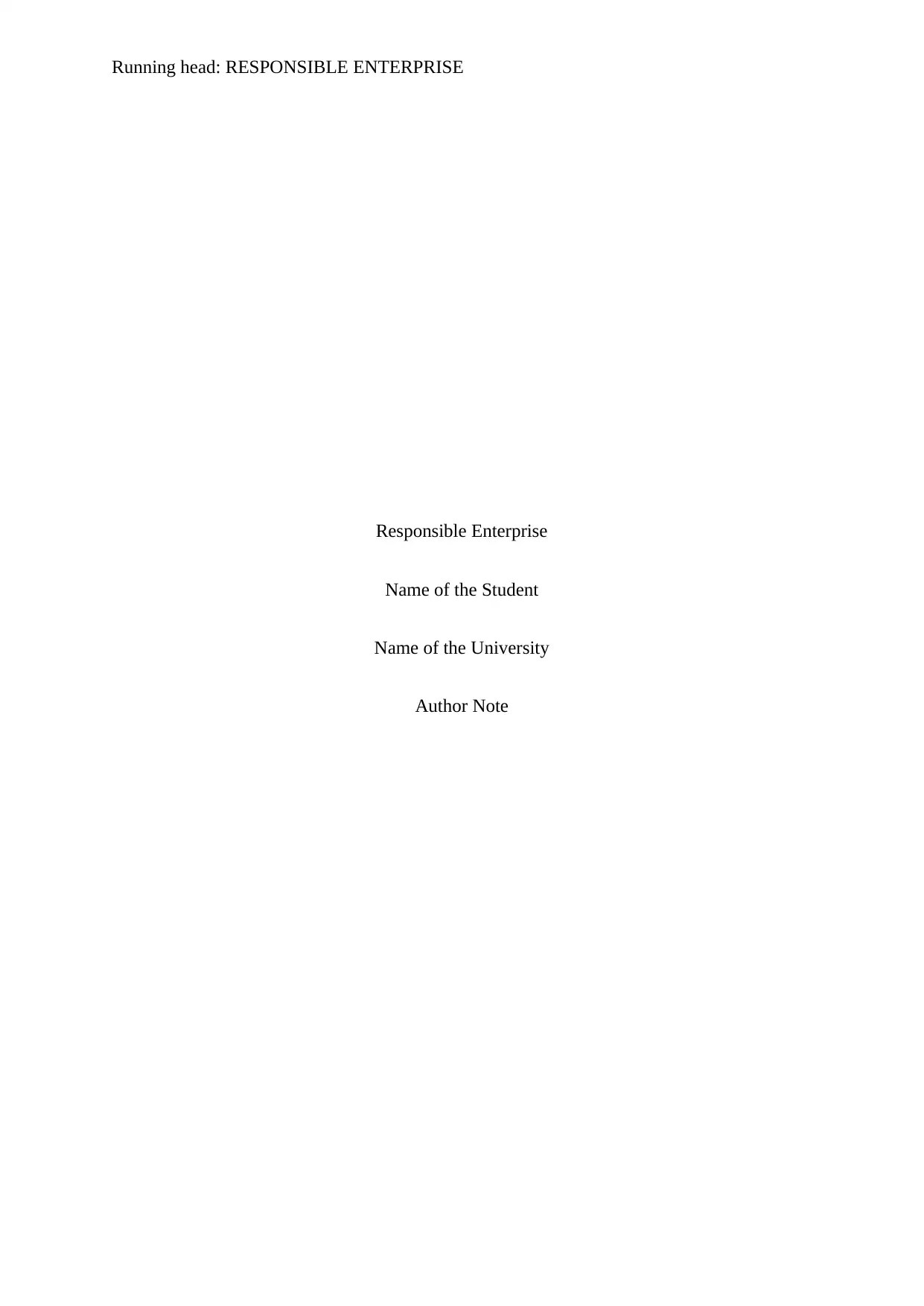
Running head: RESPONSIBLE ENTERPRISE
Responsible Enterprise
Name of the Student
Name of the University
Author Note
Responsible Enterprise
Name of the Student
Name of the University
Author Note
Paraphrase This Document
Need a fresh take? Get an instant paraphrase of this document with our AI Paraphraser
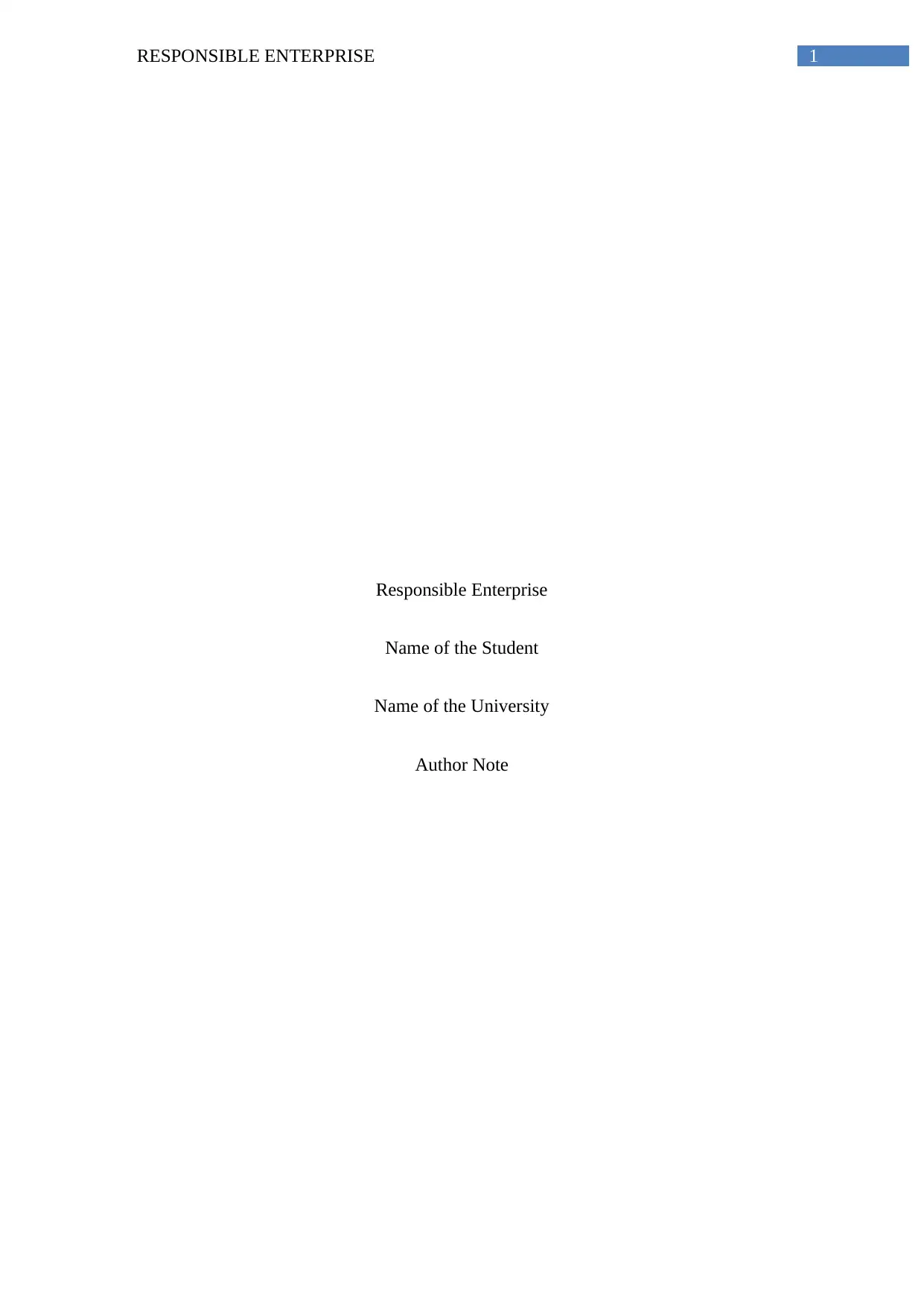
1RESPONSIBLE ENTERPRISE
Responsible Enterprise
Name of the Student
Name of the University
Author Note
Responsible Enterprise
Name of the Student
Name of the University
Author Note
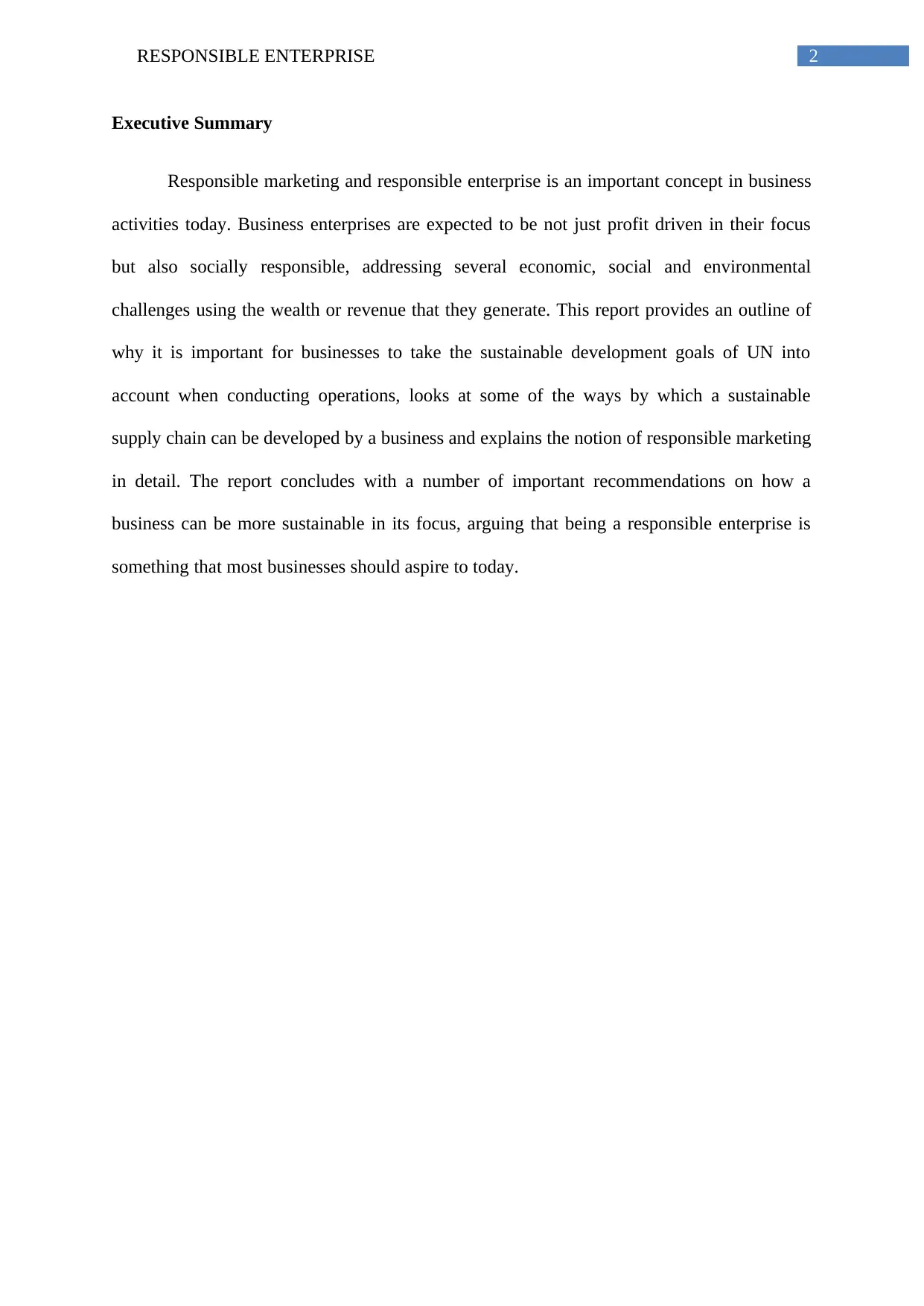
2RESPONSIBLE ENTERPRISE
Executive Summary
Responsible marketing and responsible enterprise is an important concept in business
activities today. Business enterprises are expected to be not just profit driven in their focus
but also socially responsible, addressing several economic, social and environmental
challenges using the wealth or revenue that they generate. This report provides an outline of
why it is important for businesses to take the sustainable development goals of UN into
account when conducting operations, looks at some of the ways by which a sustainable
supply chain can be developed by a business and explains the notion of responsible marketing
in detail. The report concludes with a number of important recommendations on how a
business can be more sustainable in its focus, arguing that being a responsible enterprise is
something that most businesses should aspire to today.
Executive Summary
Responsible marketing and responsible enterprise is an important concept in business
activities today. Business enterprises are expected to be not just profit driven in their focus
but also socially responsible, addressing several economic, social and environmental
challenges using the wealth or revenue that they generate. This report provides an outline of
why it is important for businesses to take the sustainable development goals of UN into
account when conducting operations, looks at some of the ways by which a sustainable
supply chain can be developed by a business and explains the notion of responsible marketing
in detail. The report concludes with a number of important recommendations on how a
business can be more sustainable in its focus, arguing that being a responsible enterprise is
something that most businesses should aspire to today.
⊘ This is a preview!⊘
Do you want full access?
Subscribe today to unlock all pages.

Trusted by 1+ million students worldwide
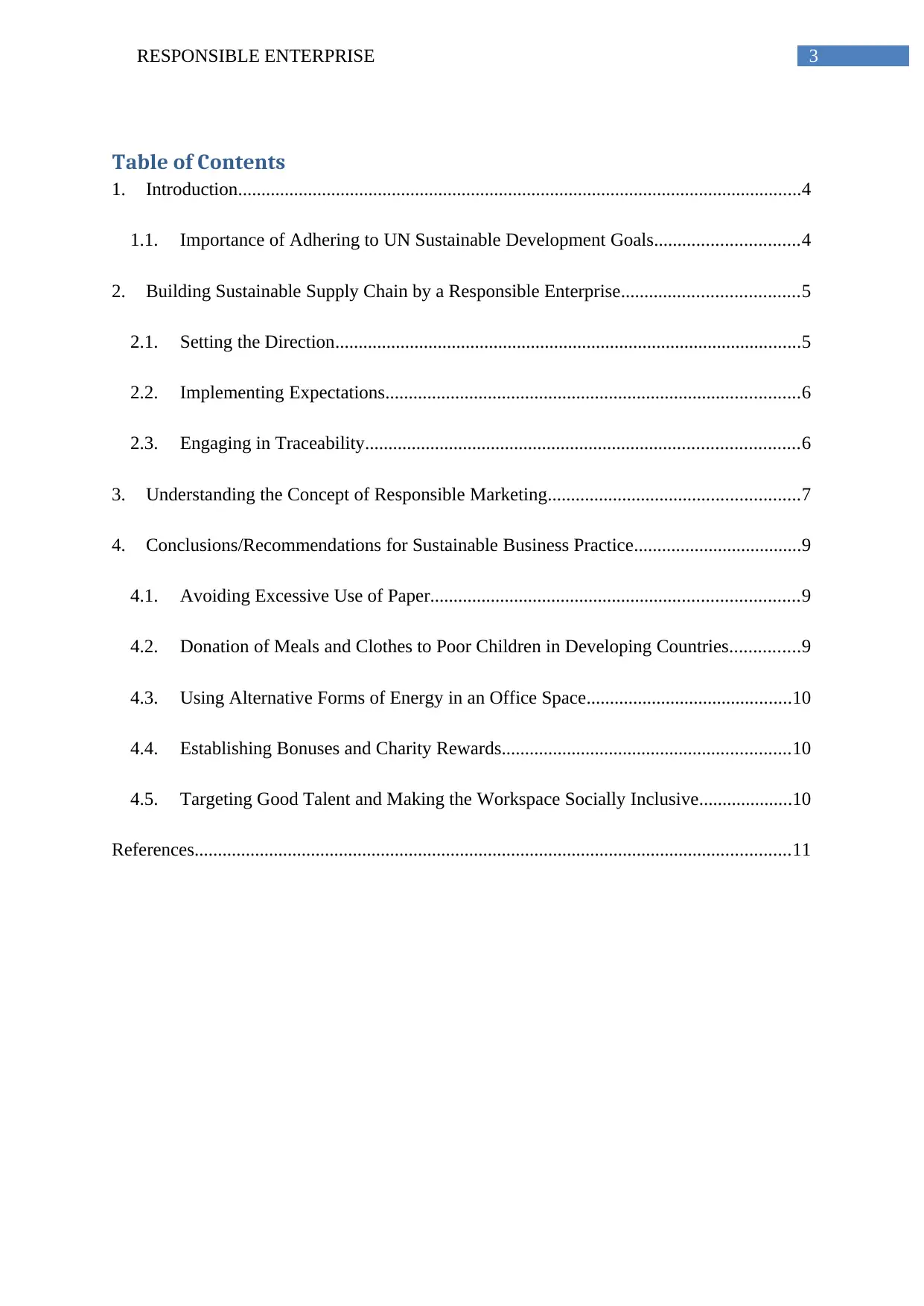
3RESPONSIBLE ENTERPRISE
Table of Contents
1. Introduction.........................................................................................................................4
1.1. Importance of Adhering to UN Sustainable Development Goals...............................4
2. Building Sustainable Supply Chain by a Responsible Enterprise......................................5
2.1. Setting the Direction....................................................................................................5
2.2. Implementing Expectations.........................................................................................6
2.3. Engaging in Traceability.............................................................................................6
3. Understanding the Concept of Responsible Marketing......................................................7
4. Conclusions/Recommendations for Sustainable Business Practice....................................9
4.1. Avoiding Excessive Use of Paper...............................................................................9
4.2. Donation of Meals and Clothes to Poor Children in Developing Countries...............9
4.3. Using Alternative Forms of Energy in an Office Space............................................10
4.4. Establishing Bonuses and Charity Rewards..............................................................10
4.5. Targeting Good Talent and Making the Workspace Socially Inclusive....................10
References................................................................................................................................11
Table of Contents
1. Introduction.........................................................................................................................4
1.1. Importance of Adhering to UN Sustainable Development Goals...............................4
2. Building Sustainable Supply Chain by a Responsible Enterprise......................................5
2.1. Setting the Direction....................................................................................................5
2.2. Implementing Expectations.........................................................................................6
2.3. Engaging in Traceability.............................................................................................6
3. Understanding the Concept of Responsible Marketing......................................................7
4. Conclusions/Recommendations for Sustainable Business Practice....................................9
4.1. Avoiding Excessive Use of Paper...............................................................................9
4.2. Donation of Meals and Clothes to Poor Children in Developing Countries...............9
4.3. Using Alternative Forms of Energy in an Office Space............................................10
4.4. Establishing Bonuses and Charity Rewards..............................................................10
4.5. Targeting Good Talent and Making the Workspace Socially Inclusive....................10
References................................................................................................................................11
Paraphrase This Document
Need a fresh take? Get an instant paraphrase of this document with our AI Paraphraser
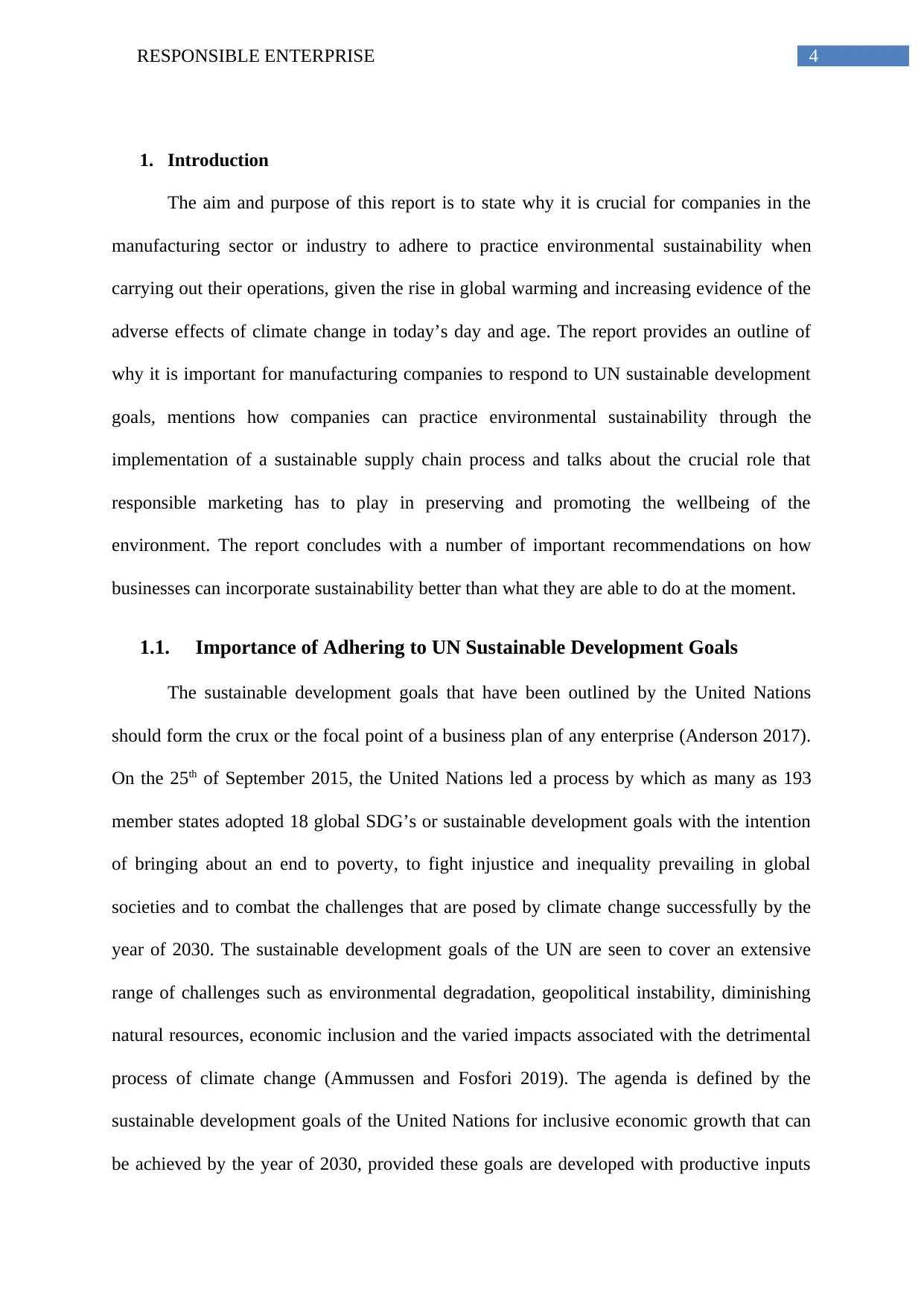
4RESPONSIBLE ENTERPRISE
1. Introduction
The aim and purpose of this report is to state why it is crucial for companies in the
manufacturing sector or industry to adhere to practice environmental sustainability when
carrying out their operations, given the rise in global warming and increasing evidence of the
adverse effects of climate change in today’s day and age. The report provides an outline of
why it is important for manufacturing companies to respond to UN sustainable development
goals, mentions how companies can practice environmental sustainability through the
implementation of a sustainable supply chain process and talks about the crucial role that
responsible marketing has to play in preserving and promoting the wellbeing of the
environment. The report concludes with a number of important recommendations on how
businesses can incorporate sustainability better than what they are able to do at the moment.
1.1. Importance of Adhering to UN Sustainable Development Goals
The sustainable development goals that have been outlined by the United Nations
should form the crux or the focal point of a business plan of any enterprise (Anderson 2017).
On the 25th of September 2015, the United Nations led a process by which as many as 193
member states adopted 18 global SDG’s or sustainable development goals with the intention
of bringing about an end to poverty, to fight injustice and inequality prevailing in global
societies and to combat the challenges that are posed by climate change successfully by the
year of 2030. The sustainable development goals of the UN are seen to cover an extensive
range of challenges such as environmental degradation, geopolitical instability, diminishing
natural resources, economic inclusion and the varied impacts associated with the detrimental
process of climate change (Ammussen and Fosfori 2019). The agenda is defined by the
sustainable development goals of the United Nations for inclusive economic growth that can
be achieved by the year of 2030, provided these goals are developed with productive inputs
1. Introduction
The aim and purpose of this report is to state why it is crucial for companies in the
manufacturing sector or industry to adhere to practice environmental sustainability when
carrying out their operations, given the rise in global warming and increasing evidence of the
adverse effects of climate change in today’s day and age. The report provides an outline of
why it is important for manufacturing companies to respond to UN sustainable development
goals, mentions how companies can practice environmental sustainability through the
implementation of a sustainable supply chain process and talks about the crucial role that
responsible marketing has to play in preserving and promoting the wellbeing of the
environment. The report concludes with a number of important recommendations on how
businesses can incorporate sustainability better than what they are able to do at the moment.
1.1. Importance of Adhering to UN Sustainable Development Goals
The sustainable development goals that have been outlined by the United Nations
should form the crux or the focal point of a business plan of any enterprise (Anderson 2017).
On the 25th of September 2015, the United Nations led a process by which as many as 193
member states adopted 18 global SDG’s or sustainable development goals with the intention
of bringing about an end to poverty, to fight injustice and inequality prevailing in global
societies and to combat the challenges that are posed by climate change successfully by the
year of 2030. The sustainable development goals of the UN are seen to cover an extensive
range of challenges such as environmental degradation, geopolitical instability, diminishing
natural resources, economic inclusion and the varied impacts associated with the detrimental
process of climate change (Ammussen and Fosfori 2019). The agenda is defined by the
sustainable development goals of the United Nations for inclusive economic growth that can
be achieved by the year of 2030, provided these goals are developed with productive inputs
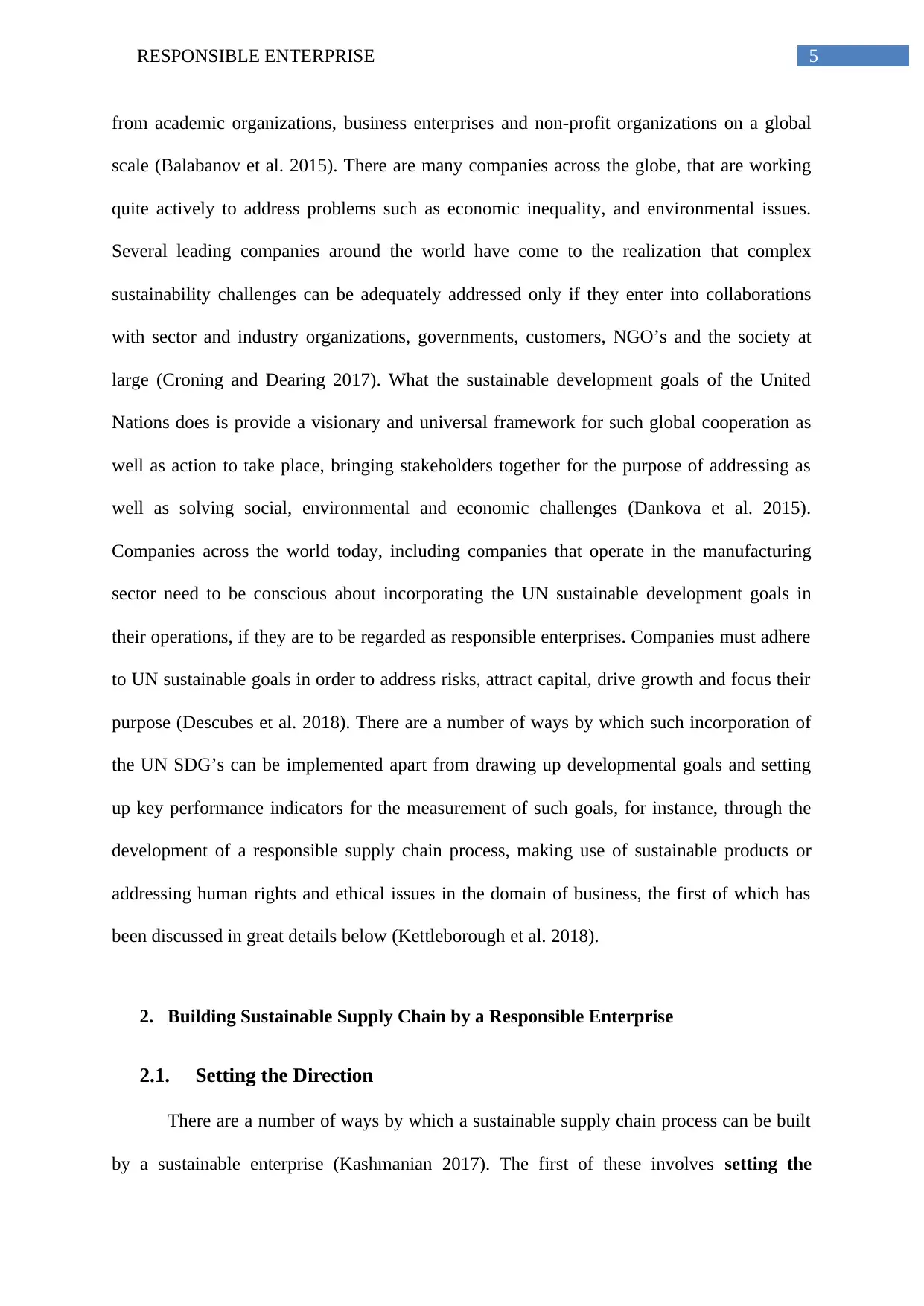
5RESPONSIBLE ENTERPRISE
from academic organizations, business enterprises and non-profit organizations on a global
scale (Balabanov et al. 2015). There are many companies across the globe, that are working
quite actively to address problems such as economic inequality, and environmental issues.
Several leading companies around the world have come to the realization that complex
sustainability challenges can be adequately addressed only if they enter into collaborations
with sector and industry organizations, governments, customers, NGO’s and the society at
large (Croning and Dearing 2017). What the sustainable development goals of the United
Nations does is provide a visionary and universal framework for such global cooperation as
well as action to take place, bringing stakeholders together for the purpose of addressing as
well as solving social, environmental and economic challenges (Dankova et al. 2015).
Companies across the world today, including companies that operate in the manufacturing
sector need to be conscious about incorporating the UN sustainable development goals in
their operations, if they are to be regarded as responsible enterprises. Companies must adhere
to UN sustainable goals in order to address risks, attract capital, drive growth and focus their
purpose (Descubes et al. 2018). There are a number of ways by which such incorporation of
the UN SDG’s can be implemented apart from drawing up developmental goals and setting
up key performance indicators for the measurement of such goals, for instance, through the
development of a responsible supply chain process, making use of sustainable products or
addressing human rights and ethical issues in the domain of business, the first of which has
been discussed in great details below (Kettleborough et al. 2018).
2. Building Sustainable Supply Chain by a Responsible Enterprise
2.1. Setting the Direction
There are a number of ways by which a sustainable supply chain process can be built
by a sustainable enterprise (Kashmanian 2017). The first of these involves setting the
from academic organizations, business enterprises and non-profit organizations on a global
scale (Balabanov et al. 2015). There are many companies across the globe, that are working
quite actively to address problems such as economic inequality, and environmental issues.
Several leading companies around the world have come to the realization that complex
sustainability challenges can be adequately addressed only if they enter into collaborations
with sector and industry organizations, governments, customers, NGO’s and the society at
large (Croning and Dearing 2017). What the sustainable development goals of the United
Nations does is provide a visionary and universal framework for such global cooperation as
well as action to take place, bringing stakeholders together for the purpose of addressing as
well as solving social, environmental and economic challenges (Dankova et al. 2015).
Companies across the world today, including companies that operate in the manufacturing
sector need to be conscious about incorporating the UN sustainable development goals in
their operations, if they are to be regarded as responsible enterprises. Companies must adhere
to UN sustainable goals in order to address risks, attract capital, drive growth and focus their
purpose (Descubes et al. 2018). There are a number of ways by which such incorporation of
the UN SDG’s can be implemented apart from drawing up developmental goals and setting
up key performance indicators for the measurement of such goals, for instance, through the
development of a responsible supply chain process, making use of sustainable products or
addressing human rights and ethical issues in the domain of business, the first of which has
been discussed in great details below (Kettleborough et al. 2018).
2. Building Sustainable Supply Chain by a Responsible Enterprise
2.1. Setting the Direction
There are a number of ways by which a sustainable supply chain process can be built
by a sustainable enterprise (Kashmanian 2017). The first of these involves setting the
⊘ This is a preview!⊘
Do you want full access?
Subscribe today to unlock all pages.

Trusted by 1+ million students worldwide
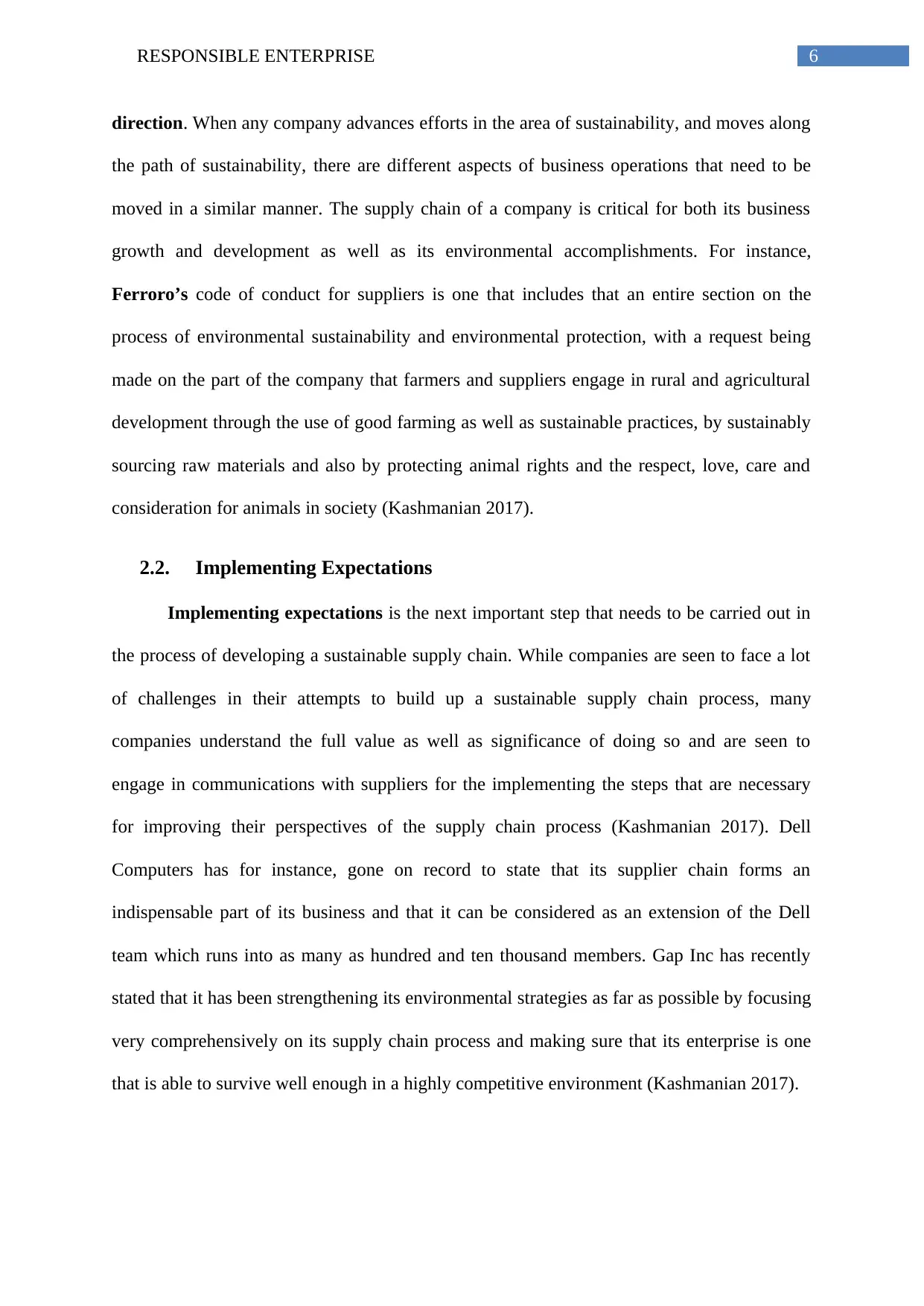
6RESPONSIBLE ENTERPRISE
direction. When any company advances efforts in the area of sustainability, and moves along
the path of sustainability, there are different aspects of business operations that need to be
moved in a similar manner. The supply chain of a company is critical for both its business
growth and development as well as its environmental accomplishments. For instance,
Ferroro’s code of conduct for suppliers is one that includes that an entire section on the
process of environmental sustainability and environmental protection, with a request being
made on the part of the company that farmers and suppliers engage in rural and agricultural
development through the use of good farming as well as sustainable practices, by sustainably
sourcing raw materials and also by protecting animal rights and the respect, love, care and
consideration for animals in society (Kashmanian 2017).
2.2. Implementing Expectations
Implementing expectations is the next important step that needs to be carried out in
the process of developing a sustainable supply chain. While companies are seen to face a lot
of challenges in their attempts to build up a sustainable supply chain process, many
companies understand the full value as well as significance of doing so and are seen to
engage in communications with suppliers for the implementing the steps that are necessary
for improving their perspectives of the supply chain process (Kashmanian 2017). Dell
Computers has for instance, gone on record to state that its supplier chain forms an
indispensable part of its business and that it can be considered as an extension of the Dell
team which runs into as many as hundred and ten thousand members. Gap Inc has recently
stated that it has been strengthening its environmental strategies as far as possible by focusing
very comprehensively on its supply chain process and making sure that its enterprise is one
that is able to survive well enough in a highly competitive environment (Kashmanian 2017).
direction. When any company advances efforts in the area of sustainability, and moves along
the path of sustainability, there are different aspects of business operations that need to be
moved in a similar manner. The supply chain of a company is critical for both its business
growth and development as well as its environmental accomplishments. For instance,
Ferroro’s code of conduct for suppliers is one that includes that an entire section on the
process of environmental sustainability and environmental protection, with a request being
made on the part of the company that farmers and suppliers engage in rural and agricultural
development through the use of good farming as well as sustainable practices, by sustainably
sourcing raw materials and also by protecting animal rights and the respect, love, care and
consideration for animals in society (Kashmanian 2017).
2.2. Implementing Expectations
Implementing expectations is the next important step that needs to be carried out in
the process of developing a sustainable supply chain. While companies are seen to face a lot
of challenges in their attempts to build up a sustainable supply chain process, many
companies understand the full value as well as significance of doing so and are seen to
engage in communications with suppliers for the implementing the steps that are necessary
for improving their perspectives of the supply chain process (Kashmanian 2017). Dell
Computers has for instance, gone on record to state that its supplier chain forms an
indispensable part of its business and that it can be considered as an extension of the Dell
team which runs into as many as hundred and ten thousand members. Gap Inc has recently
stated that it has been strengthening its environmental strategies as far as possible by focusing
very comprehensively on its supply chain process and making sure that its enterprise is one
that is able to survive well enough in a highly competitive environment (Kashmanian 2017).
Paraphrase This Document
Need a fresh take? Get an instant paraphrase of this document with our AI Paraphraser
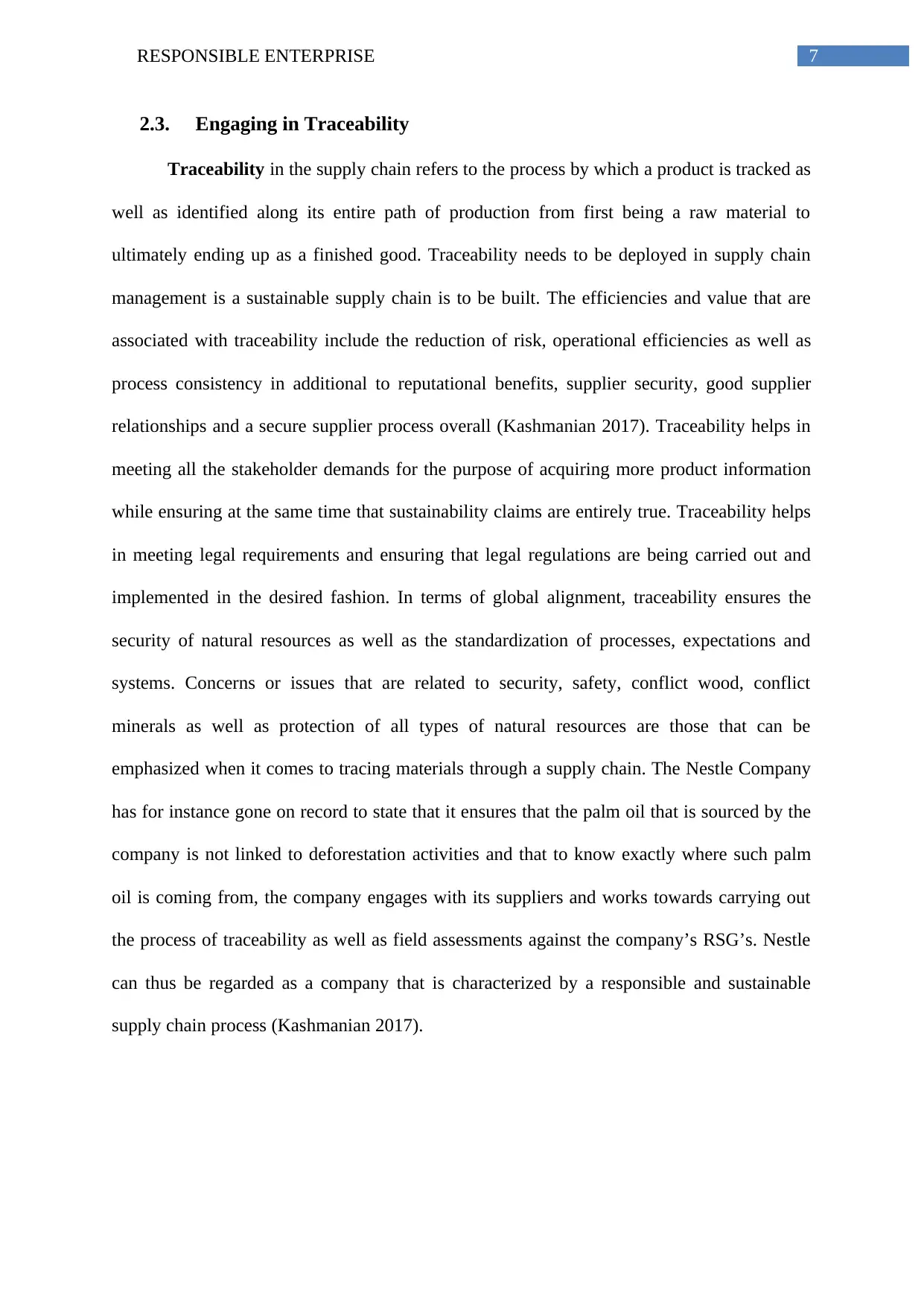
7RESPONSIBLE ENTERPRISE
2.3. Engaging in Traceability
Traceability in the supply chain refers to the process by which a product is tracked as
well as identified along its entire path of production from first being a raw material to
ultimately ending up as a finished good. Traceability needs to be deployed in supply chain
management is a sustainable supply chain is to be built. The efficiencies and value that are
associated with traceability include the reduction of risk, operational efficiencies as well as
process consistency in additional to reputational benefits, supplier security, good supplier
relationships and a secure supplier process overall (Kashmanian 2017). Traceability helps in
meeting all the stakeholder demands for the purpose of acquiring more product information
while ensuring at the same time that sustainability claims are entirely true. Traceability helps
in meeting legal requirements and ensuring that legal regulations are being carried out and
implemented in the desired fashion. In terms of global alignment, traceability ensures the
security of natural resources as well as the standardization of processes, expectations and
systems. Concerns or issues that are related to security, safety, conflict wood, conflict
minerals as well as protection of all types of natural resources are those that can be
emphasized when it comes to tracing materials through a supply chain. The Nestle Company
has for instance gone on record to state that it ensures that the palm oil that is sourced by the
company is not linked to deforestation activities and that to know exactly where such palm
oil is coming from, the company engages with its suppliers and works towards carrying out
the process of traceability as well as field assessments against the company’s RSG’s. Nestle
can thus be regarded as a company that is characterized by a responsible and sustainable
supply chain process (Kashmanian 2017).
2.3. Engaging in Traceability
Traceability in the supply chain refers to the process by which a product is tracked as
well as identified along its entire path of production from first being a raw material to
ultimately ending up as a finished good. Traceability needs to be deployed in supply chain
management is a sustainable supply chain is to be built. The efficiencies and value that are
associated with traceability include the reduction of risk, operational efficiencies as well as
process consistency in additional to reputational benefits, supplier security, good supplier
relationships and a secure supplier process overall (Kashmanian 2017). Traceability helps in
meeting all the stakeholder demands for the purpose of acquiring more product information
while ensuring at the same time that sustainability claims are entirely true. Traceability helps
in meeting legal requirements and ensuring that legal regulations are being carried out and
implemented in the desired fashion. In terms of global alignment, traceability ensures the
security of natural resources as well as the standardization of processes, expectations and
systems. Concerns or issues that are related to security, safety, conflict wood, conflict
minerals as well as protection of all types of natural resources are those that can be
emphasized when it comes to tracing materials through a supply chain. The Nestle Company
has for instance gone on record to state that it ensures that the palm oil that is sourced by the
company is not linked to deforestation activities and that to know exactly where such palm
oil is coming from, the company engages with its suppliers and works towards carrying out
the process of traceability as well as field assessments against the company’s RSG’s. Nestle
can thus be regarded as a company that is characterized by a responsible and sustainable
supply chain process (Kashmanian 2017).
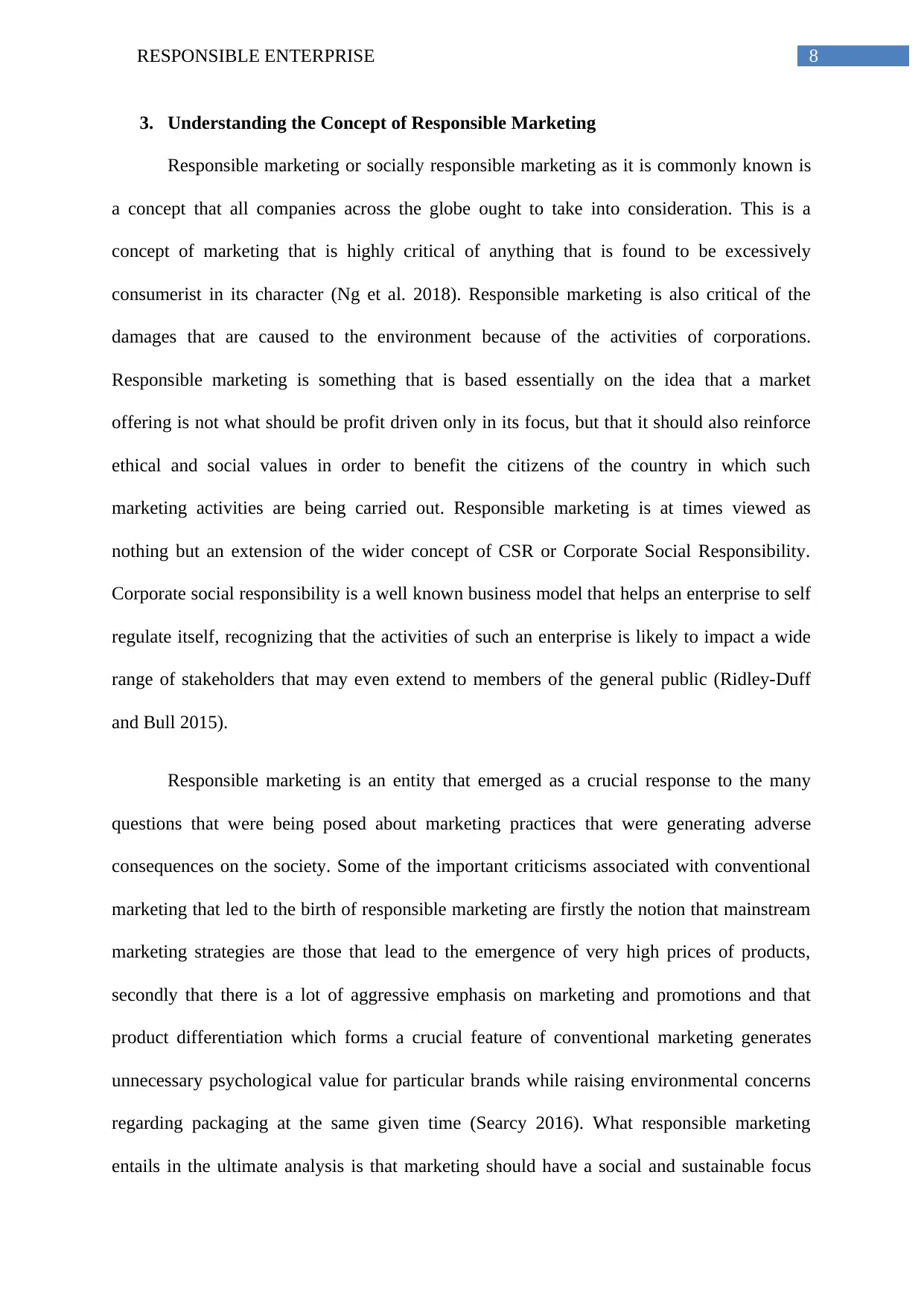
8RESPONSIBLE ENTERPRISE
3. Understanding the Concept of Responsible Marketing
Responsible marketing or socially responsible marketing as it is commonly known is
a concept that all companies across the globe ought to take into consideration. This is a
concept of marketing that is highly critical of anything that is found to be excessively
consumerist in its character (Ng et al. 2018). Responsible marketing is also critical of the
damages that are caused to the environment because of the activities of corporations.
Responsible marketing is something that is based essentially on the idea that a market
offering is not what should be profit driven only in its focus, but that it should also reinforce
ethical and social values in order to benefit the citizens of the country in which such
marketing activities are being carried out. Responsible marketing is at times viewed as
nothing but an extension of the wider concept of CSR or Corporate Social Responsibility.
Corporate social responsibility is a well known business model that helps an enterprise to self
regulate itself, recognizing that the activities of such an enterprise is likely to impact a wide
range of stakeholders that may even extend to members of the general public (Ridley-Duff
and Bull 2015).
Responsible marketing is an entity that emerged as a crucial response to the many
questions that were being posed about marketing practices that were generating adverse
consequences on the society. Some of the important criticisms associated with conventional
marketing that led to the birth of responsible marketing are firstly the notion that mainstream
marketing strategies are those that lead to the emergence of very high prices of products,
secondly that there is a lot of aggressive emphasis on marketing and promotions and that
product differentiation which forms a crucial feature of conventional marketing generates
unnecessary psychological value for particular brands while raising environmental concerns
regarding packaging at the same given time (Searcy 2016). What responsible marketing
entails in the ultimate analysis is that marketing should have a social and sustainable focus
3. Understanding the Concept of Responsible Marketing
Responsible marketing or socially responsible marketing as it is commonly known is
a concept that all companies across the globe ought to take into consideration. This is a
concept of marketing that is highly critical of anything that is found to be excessively
consumerist in its character (Ng et al. 2018). Responsible marketing is also critical of the
damages that are caused to the environment because of the activities of corporations.
Responsible marketing is something that is based essentially on the idea that a market
offering is not what should be profit driven only in its focus, but that it should also reinforce
ethical and social values in order to benefit the citizens of the country in which such
marketing activities are being carried out. Responsible marketing is at times viewed as
nothing but an extension of the wider concept of CSR or Corporate Social Responsibility.
Corporate social responsibility is a well known business model that helps an enterprise to self
regulate itself, recognizing that the activities of such an enterprise is likely to impact a wide
range of stakeholders that may even extend to members of the general public (Ridley-Duff
and Bull 2015).
Responsible marketing is an entity that emerged as a crucial response to the many
questions that were being posed about marketing practices that were generating adverse
consequences on the society. Some of the important criticisms associated with conventional
marketing that led to the birth of responsible marketing are firstly the notion that mainstream
marketing strategies are those that lead to the emergence of very high prices of products,
secondly that there is a lot of aggressive emphasis on marketing and promotions and that
product differentiation which forms a crucial feature of conventional marketing generates
unnecessary psychological value for particular brands while raising environmental concerns
regarding packaging at the same given time (Searcy 2016). What responsible marketing
entails in the ultimate analysis is that marketing should have a social and sustainable focus
⊘ This is a preview!⊘
Do you want full access?
Subscribe today to unlock all pages.

Trusted by 1+ million students worldwide
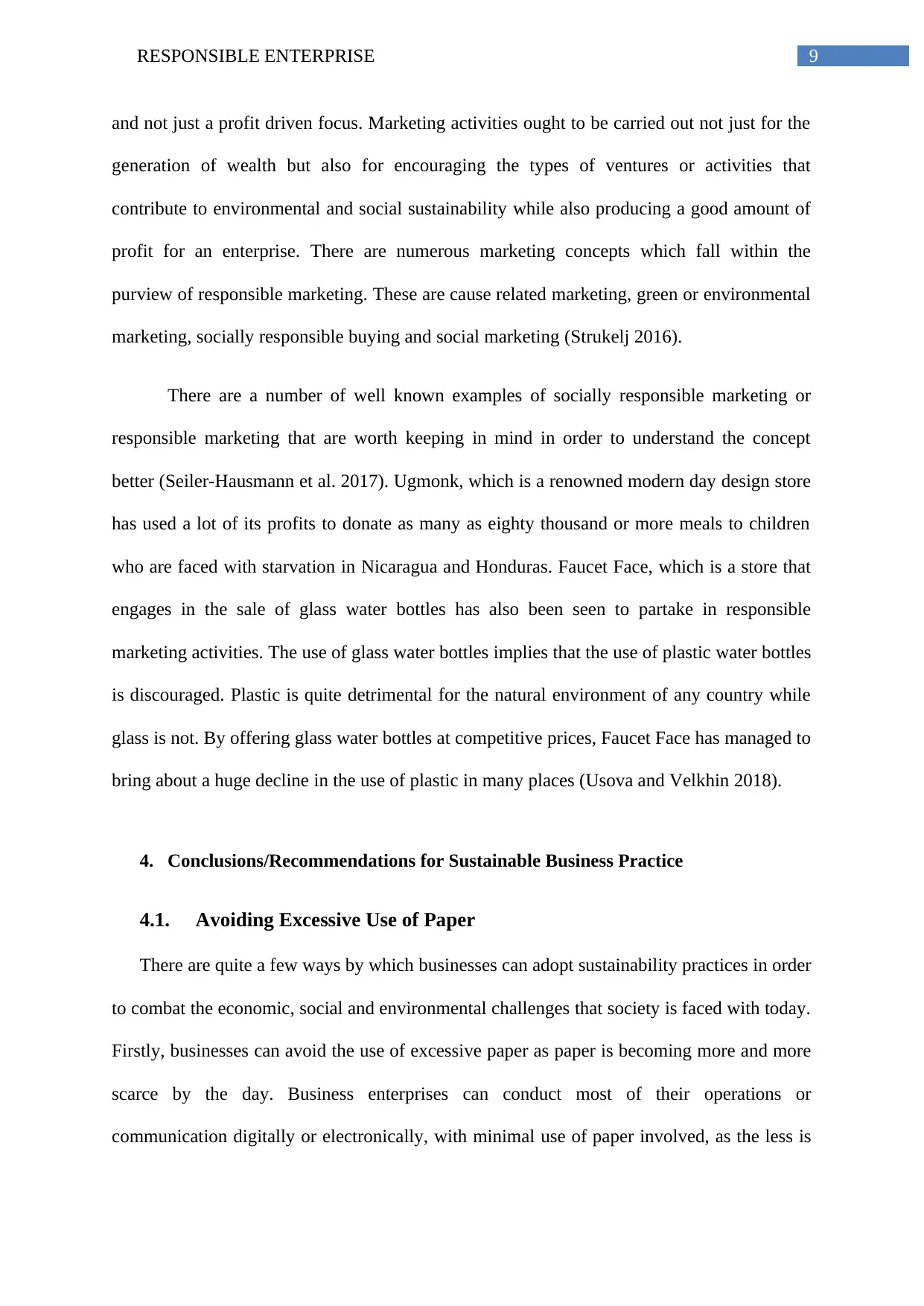
9RESPONSIBLE ENTERPRISE
and not just a profit driven focus. Marketing activities ought to be carried out not just for the
generation of wealth but also for encouraging the types of ventures or activities that
contribute to environmental and social sustainability while also producing a good amount of
profit for an enterprise. There are numerous marketing concepts which fall within the
purview of responsible marketing. These are cause related marketing, green or environmental
marketing, socially responsible buying and social marketing (Strukelj 2016).
There are a number of well known examples of socially responsible marketing or
responsible marketing that are worth keeping in mind in order to understand the concept
better (Seiler-Hausmann et al. 2017). Ugmonk, which is a renowned modern day design store
has used a lot of its profits to donate as many as eighty thousand or more meals to children
who are faced with starvation in Nicaragua and Honduras. Faucet Face, which is a store that
engages in the sale of glass water bottles has also been seen to partake in responsible
marketing activities. The use of glass water bottles implies that the use of plastic water bottles
is discouraged. Plastic is quite detrimental for the natural environment of any country while
glass is not. By offering glass water bottles at competitive prices, Faucet Face has managed to
bring about a huge decline in the use of plastic in many places (Usova and Velkhin 2018).
4. Conclusions/Recommendations for Sustainable Business Practice
4.1. Avoiding Excessive Use of Paper
There are quite a few ways by which businesses can adopt sustainability practices in order
to combat the economic, social and environmental challenges that society is faced with today.
Firstly, businesses can avoid the use of excessive paper as paper is becoming more and more
scarce by the day. Business enterprises can conduct most of their operations or
communication digitally or electronically, with minimal use of paper involved, as the less is
and not just a profit driven focus. Marketing activities ought to be carried out not just for the
generation of wealth but also for encouraging the types of ventures or activities that
contribute to environmental and social sustainability while also producing a good amount of
profit for an enterprise. There are numerous marketing concepts which fall within the
purview of responsible marketing. These are cause related marketing, green or environmental
marketing, socially responsible buying and social marketing (Strukelj 2016).
There are a number of well known examples of socially responsible marketing or
responsible marketing that are worth keeping in mind in order to understand the concept
better (Seiler-Hausmann et al. 2017). Ugmonk, which is a renowned modern day design store
has used a lot of its profits to donate as many as eighty thousand or more meals to children
who are faced with starvation in Nicaragua and Honduras. Faucet Face, which is a store that
engages in the sale of glass water bottles has also been seen to partake in responsible
marketing activities. The use of glass water bottles implies that the use of plastic water bottles
is discouraged. Plastic is quite detrimental for the natural environment of any country while
glass is not. By offering glass water bottles at competitive prices, Faucet Face has managed to
bring about a huge decline in the use of plastic in many places (Usova and Velkhin 2018).
4. Conclusions/Recommendations for Sustainable Business Practice
4.1. Avoiding Excessive Use of Paper
There are quite a few ways by which businesses can adopt sustainability practices in order
to combat the economic, social and environmental challenges that society is faced with today.
Firstly, businesses can avoid the use of excessive paper as paper is becoming more and more
scarce by the day. Business enterprises can conduct most of their operations or
communication digitally or electronically, with minimal use of paper involved, as the less is
Paraphrase This Document
Need a fresh take? Get an instant paraphrase of this document with our AI Paraphraser
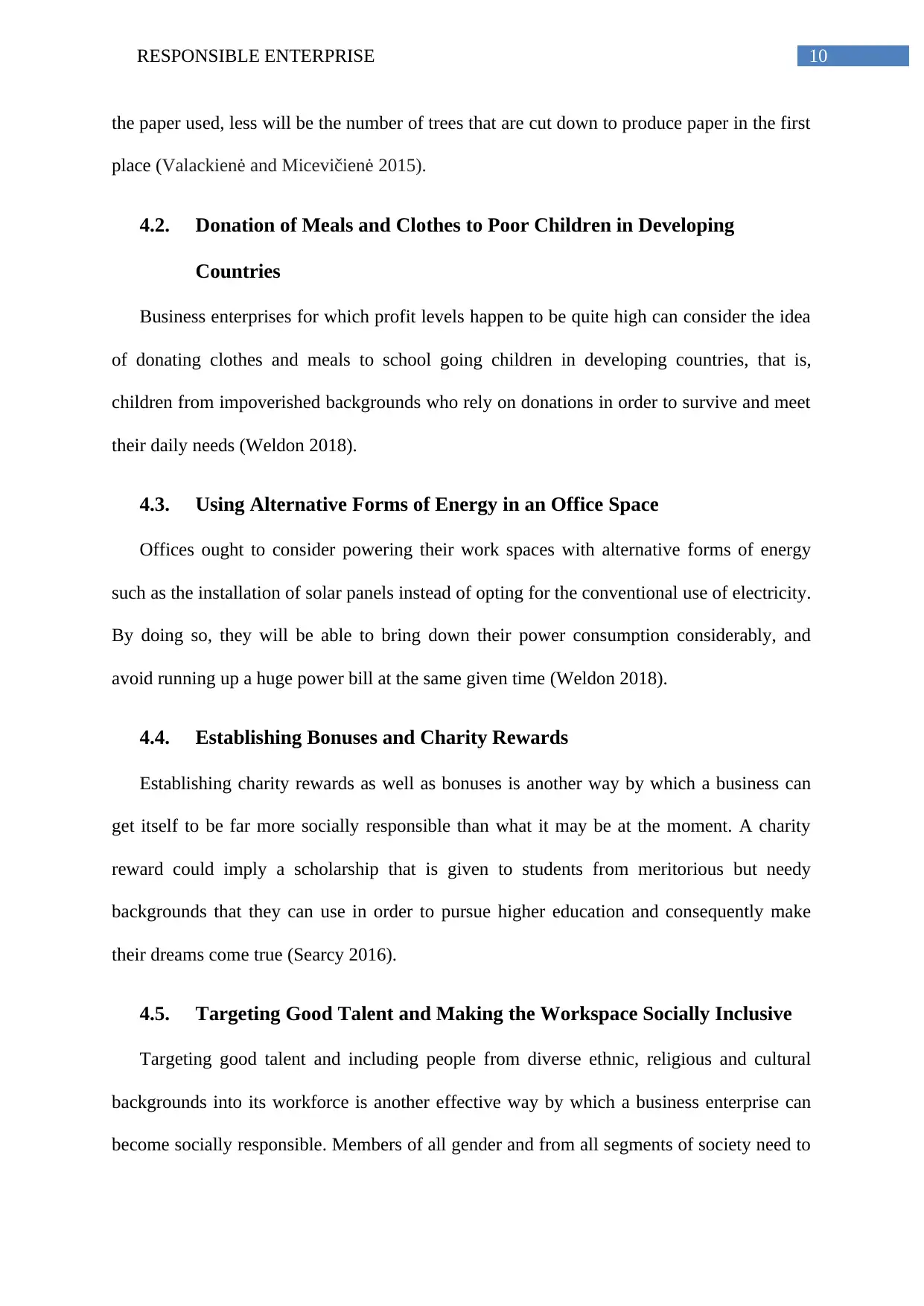
10RESPONSIBLE ENTERPRISE
the paper used, less will be the number of trees that are cut down to produce paper in the first
place (Valackienė and Micevičienė 2015).
4.2. Donation of Meals and Clothes to Poor Children in Developing
Countries
Business enterprises for which profit levels happen to be quite high can consider the idea
of donating clothes and meals to school going children in developing countries, that is,
children from impoverished backgrounds who rely on donations in order to survive and meet
their daily needs (Weldon 2018).
4.3. Using Alternative Forms of Energy in an Office Space
Offices ought to consider powering their work spaces with alternative forms of energy
such as the installation of solar panels instead of opting for the conventional use of electricity.
By doing so, they will be able to bring down their power consumption considerably, and
avoid running up a huge power bill at the same given time (Weldon 2018).
4.4. Establishing Bonuses and Charity Rewards
Establishing charity rewards as well as bonuses is another way by which a business can
get itself to be far more socially responsible than what it may be at the moment. A charity
reward could imply a scholarship that is given to students from meritorious but needy
backgrounds that they can use in order to pursue higher education and consequently make
their dreams come true (Searcy 2016).
4.5. Targeting Good Talent and Making the Workspace Socially Inclusive
Targeting good talent and including people from diverse ethnic, religious and cultural
backgrounds into its workforce is another effective way by which a business enterprise can
become socially responsible. Members of all gender and from all segments of society need to
the paper used, less will be the number of trees that are cut down to produce paper in the first
place (Valackienė and Micevičienė 2015).
4.2. Donation of Meals and Clothes to Poor Children in Developing
Countries
Business enterprises for which profit levels happen to be quite high can consider the idea
of donating clothes and meals to school going children in developing countries, that is,
children from impoverished backgrounds who rely on donations in order to survive and meet
their daily needs (Weldon 2018).
4.3. Using Alternative Forms of Energy in an Office Space
Offices ought to consider powering their work spaces with alternative forms of energy
such as the installation of solar panels instead of opting for the conventional use of electricity.
By doing so, they will be able to bring down their power consumption considerably, and
avoid running up a huge power bill at the same given time (Weldon 2018).
4.4. Establishing Bonuses and Charity Rewards
Establishing charity rewards as well as bonuses is another way by which a business can
get itself to be far more socially responsible than what it may be at the moment. A charity
reward could imply a scholarship that is given to students from meritorious but needy
backgrounds that they can use in order to pursue higher education and consequently make
their dreams come true (Searcy 2016).
4.5. Targeting Good Talent and Making the Workspace Socially Inclusive
Targeting good talent and including people from diverse ethnic, religious and cultural
backgrounds into its workforce is another effective way by which a business enterprise can
become socially responsible. Members of all gender and from all segments of society need to
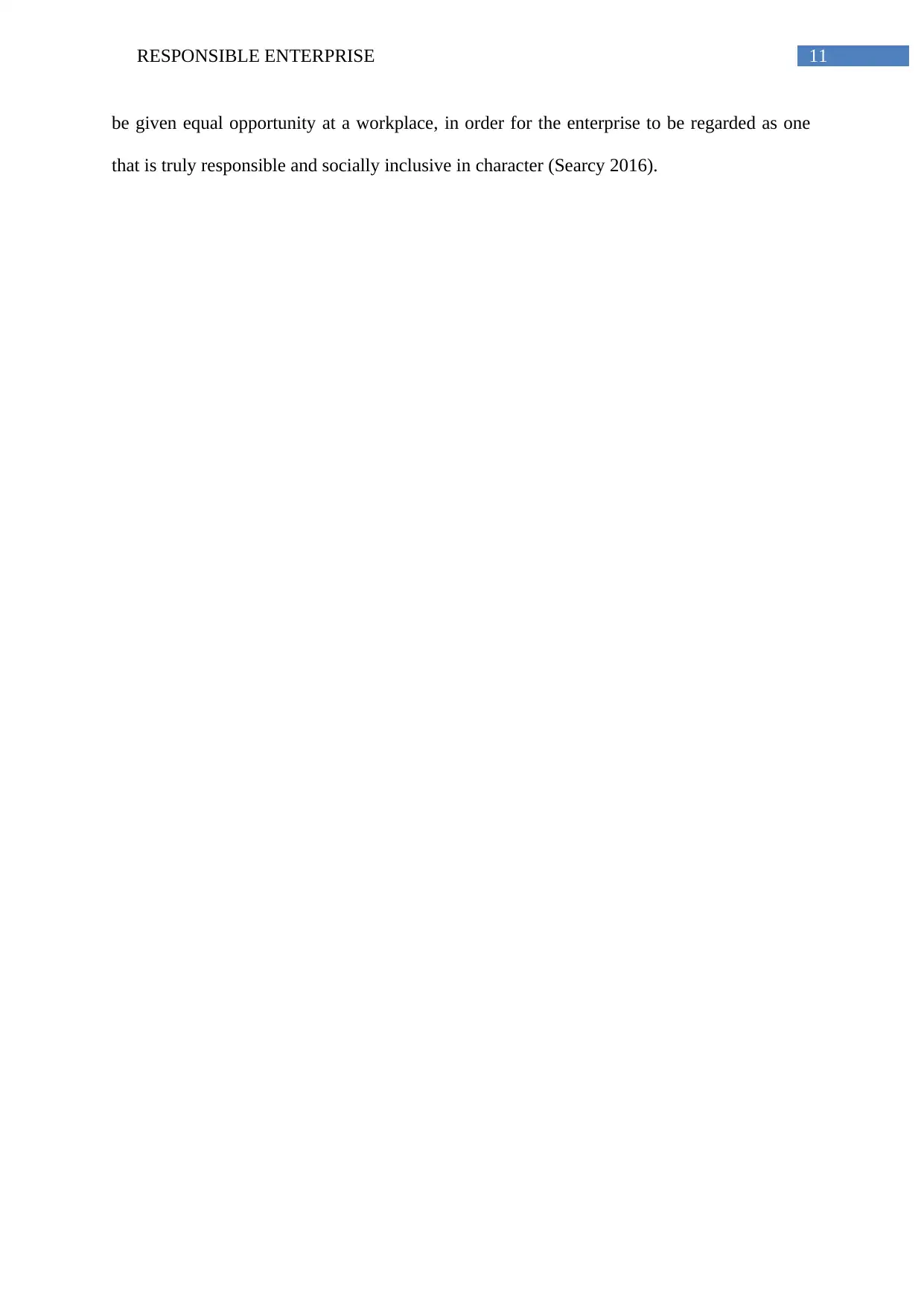
11RESPONSIBLE ENTERPRISE
be given equal opportunity at a workplace, in order for the enterprise to be regarded as one
that is truly responsible and socially inclusive in character (Searcy 2016).
be given equal opportunity at a workplace, in order for the enterprise to be regarded as one
that is truly responsible and socially inclusive in character (Searcy 2016).
⊘ This is a preview!⊘
Do you want full access?
Subscribe today to unlock all pages.

Trusted by 1+ million students worldwide
1 out of 14
Related Documents
Your All-in-One AI-Powered Toolkit for Academic Success.
+13062052269
info@desklib.com
Available 24*7 on WhatsApp / Email
![[object Object]](/_next/static/media/star-bottom.7253800d.svg)
Unlock your academic potential
Copyright © 2020–2025 A2Z Services. All Rights Reserved. Developed and managed by ZUCOL.





